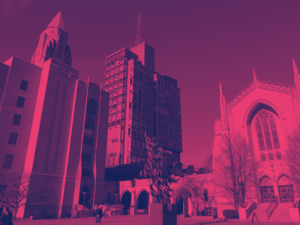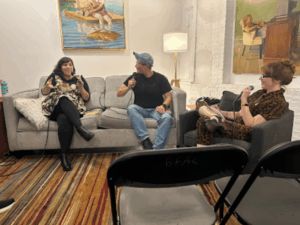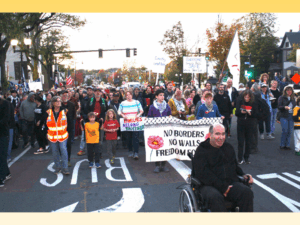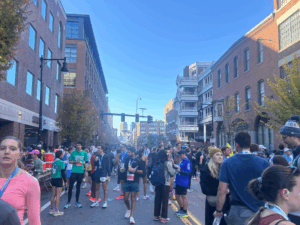“If you were trying to become a full-time photojournalist, this is one more obstacle.”
It is a school that was celebrating a milestone just two years ago, even featured on WCVB’s Chronicle for educating some of America’s great photographers for half a century.
Now, the New England School of Photography is shutting its doors for good, just a little over two years after it moved its operation from downtown Boston to Waltham.
A sadness has overcome many NESOP alum who valued the institution; at the same time, it would be wrong to say they didn’t see this coming.
The announcement officially stated that “enrolling a new group of students for the 2019-2020 academic year would be potentially untenable in the current academic year, industry and regulatory climate.” “NESOP,” a banner on the school’s web page reads, “will graduate its last class of Professional Photography Program students and close its doors this spring.”
Like many small colleges across the country and in New England, NESOP is another small institution that couldn’t cut it. The school reported its decision to close to the Massachusetts Division of Professional Licensure, a spokeswoman confirmed. The agency said it could not share more information on that filing.
NESOP administrators declined to comment when an editor from Boston Business Journal wrote about the closure, which is set to take place at the end of March. They also declined to comment for this story, but several alumni shared their thoughts on what this means for photography in the region.
New York-based photographer Scott Lacey, formerly on staff at Boston Magazine, said his education at NESOP is tied to its location in downtown Boston’s Kenmore Square. NESOP’s move from under the Citgo sign to the suburbs took place when its lease expired at the end of the 2018 academic year, following the purchase and eventual demolition of the building. For Lacey, the move out of Boston was the writing was on the wall.
“At first, I guess I was surprised when it moved out to Waltham,” Lacey, a 2010 alumnus of the school and senior visual editor at Hearst Magazines, said. “Once that happened, I could have told you that it wasn’t going to work out there.”
For longtime instructor and freelance photographer Dana Smith, tying the closure of the school to the relocation of its campus is not that simple. Smith said the school’s graduating class had been dwindling for years, from 60 full-time graduates to 25 or fewer in recent years. Smith is in the process of looking for a teaching gig to fill the one-day-a-week commitment he made to teach at NESOP for the past 20 years.
“It’s like finding out that your 105-year-old uncle died,” Smith said. “It’s sad, but it’s hardly shocking.” He added, “Knowing that most of the other schools in the area and a lot of other bigger ones in the country have already shut down, it’s just on your mind all of the time. And every new year you’re hoping that you don’t find out that they’re shutting down, so it finally came.”

Smith said culture and the industry likely contributed to the school’s decline, referring to the number of magazines, such as ESPN and Sports Illustrated, announcing last year that they are ceasing operations.
Brian Snyder, a Reuters photographer and president of the Boston Press Photographers Association, agrees with Smith on how changes in the industry could have contributed to NESOP’s demise. Snyder said there is no question that NESOP produced photojournalists who are working in the industry today, including members of the Boston-based association he heads. In Snyder’s opinion, the school’s closure doesn’t mean that those aspiring to be photographers won’t have avenues to pursue their passion.
“There’s always a need for new photographers to help out,” Snyder said. “It’s not the same amount of work as it was 30 years ago or 20 years ago. You’ve got to cobble together a living differently, but I do believe there is room for talented photographers who have something to say and are willing to do [the work].”
While some say the school’s closing is a sign of the times, Snyder counters that thought with the fact that there are jobs out there for good photographers.
“If you were trying to become a full-time photojournalist, this is one more obstacle,” Snyder said. “Like, where do I learn to do this thing and not break the bank? Certainly … if you’re willing to be stubborn and persistent and put in a lot of time, maybe it takes a little more time now and a little more persistence and a little more stubbornness to do it.”
If you ask those who taught courses and workshops, learning the craft and gaining the tools to get a job is what NESOP was all about. Smith had zero interest in photography but wanted to get an arts degree. After UMass Dartmouth required him to take a photography course, he fell in love with the medium and decided to continue his education at NESOP.
“What appealed to me [at NESOP] was that it was all photography, and it was also a professional program,” Smith said. “And the idea of getting an art degree wasn’t as appealing as learning from instructors who were actually working in the business as opposed to those who just had stacked up degrees.”
After all, photography is art, and in that sense it is taught at several schools across the region. One institution in particular, MassArt, may be appealing to aspiring photographers. During the summer of 2018, when the school announced it would be closing for good, members of the incoming class were told they could transfer to MassArt if they were concerned about the prospect of not completing their education at the initial school of their choice.
Tuition for the October 2019 and February 2020 academic years was priced $24,000 at NESOP, not including lab fees and costs related to student supplies, according to the school’s website. Smith said what’s special about NESOP is that it’s different than attending a fine arts school for several reasons.
“You have university-taught teachers teaching university students and it’s not like a trade school,” Smith said of schools such as MassArt.
“I’ve had students who came from UMass and said, ‘Look, I’ve got this formal education, but I really want to work.’ And they came to NESOP for two years to learn the business and to learn how to go out there and get jobs, which is not necessarily something that MassArt would teach or any similar schools like that.”
One of the draws of the school was that it augmented a formal education. NESOP also provided the flexibility to attend later on in life, as Lacey had at the age of 29.
“I just wanted to go back to school to kind of like dive more into that, so I ended up going there for two years,” said Lacey, whose work includes Oprah Magazine, Women’s Health, and books for well-known figures, including Barack and Michelle Obama.
Smith said it was common to have 18- to 22-year-olds working alongside classmates who were in their 40s and 50s.
“I had one student that owned a really successful deli up in Brookline, but he wanted to be a photographer,” Smith said. “I think it’s tough. Once you have a family, once you have life-stuff and you’re in your 30s or 40s or 50s, it’s really difficult to take four years out of your life to get a degree. But I think with NESOP it was more doable.”
Michele Kellis, a photographer in southern Maine who’s been shooting since 1983, said she planned on attending the school before it shuttered.
“I had been mulling it over for a few years and had I known, I would have pursued my education further there,” Kellis wrote in an email. “I definitely missed out on the opportunity, which are so few for photographers, to go to any type of brick-and-mortar learning institution.”
Joseph Keller, a 1991 graduate who runs Keller and Keller photography in Boston, said the school is likely a victim of the digital age. Fewer and fewer people, he said, are willing to spend their money and time to learn photography. Keller, who runs a studio focused on lifestyle and food photography, said nowadays he’s competing with Instagrammers and bloggers.
“The newer generations, I think, are more willing to learn online and value traditional classroom learning less,” the 1991 alumnus said. “There’s a proliferation of online universities, [so] I think it’s just a trend that has caused the school to close.”
An influx of self-taught photographers emerging in the industry is also something that Heather McGrath, a 2006 alumnus and a co-founder of Parachute Studios for artists in South Boston, has noticed. The commercial photographer and filmmaker said were it not for professors like Smith and the super-focused technical training she received at NESOP, her path in life would be different.
“Digital photography changed a lot of shit,” McGrath said. “I don’t know how kids are going to learn what I was taught without that kind of one-on-one [education].”
David Butler, a commercial product brand and advertising photographer who owns a studio in East Boston, also valued the intensity of the photography program at NESOP, which he referred to “life-changing.”
Butler, a 2008 graduate, recalls being on campus from sunup to sun down as a student. Learning the technicalities of lighting and how to go about photography, Butler said, are just some of the skills he gained at NESOP that he still uses today. While an education in some of those practical skills will be lost once the school closes, Butler argues that those interested in photography could also lose the helpful critiques and advice he got as a student.
“It’s hard because it’s certainly an expensive program and it’s an investment, and people are finding ways to learn at a much cheaper and a more comfortable surrounding,” Butler said. “If you’re looking to learn photography, I would certainly seek out a community, and that was what NESOP was for me for a long time—it’s just a community of people that will help push you to try new techniques or see things in a new way or dig deeper in yourself.”








